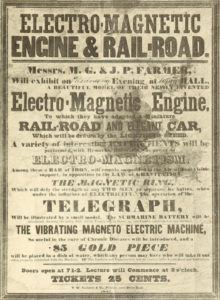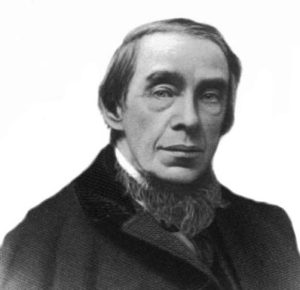 by Steven Green
by Steven Green
Born February 9, 1820 to Colonel John and Sally (Gerrish) Farmer in Boscawen, New Hampshire, Moses Gerrish Farmer was an inventor and pioneer in the field of electricity.
He attended Phillips Academy, Andover MA in the autumn of 1837 and later Dartmouth College in 1840. He was soon teaching at the Academy at Eliot, Maine, where he met and married Hannah Tobey Shapleigh, one of his students. They had one daughter, Sarah Jane Farmer.

In 1852, he and his partner William F. Channing patented the first electric fire alarm system, and installed it in Boston that same year.
In 1855, he discovered the means for duplex and quadruplex telegraph, i.e. sending more than one message over the line at the same time. He successfully demonstrated this between New York and Philadelphia in 1856.
In 1858, he installed a form of incandescent lighting in one of the rooms in his home in Salem, Massachusetts, illuminating it for a number of months. This was some twenty years before Thomas Edison’s success.
In 1872 Farmer was appointed to the office of electrician at the United States Torpedo Station at Newport, Rhode Island. For the next nine years he helped advance torpedo warfare until his health forced him to resign. He acted as consulting electrician for the United States Electric Light Company of New York for several years before retiring with his family to their summer home at Eliot, Maine where he established a public library.
His wife, Hannah Tobey Shapleigh Farmer, was an outspoken suffragette who operated the Rosemary Cottage, a rural retreat for urban unwed mothers and their children. The Farmers’ home was a way station on the Underground Railroad that helped slaves escape the South.
Moses Gerrish Farmer died at the 1893 World’s Fair in Chicago on May 25th, while he was preparing an exhibit of his inventions.
The following describes an article written for the Dartmouth Alumni magazine by one of his classmates at Dartmouth, Ralph S. Bartlett.
The current issue of the Dartmouth magazine contains an article written by Ralph S. Bartlett of the Class of 1889, the secretary of that class. The article is entitled “An Early Dartmouth Inventor”, and begins like this: “Sixty-five years ago this June a letter was received in Hanover by the 1889-class secretary a few days before commencement. This letter was written by Moses Gerrish Farmer, a native of Boscawen, N.H., a member of the class of 1844 at Dartmouth, who in retirement was then living in Eliot, Maine, in which town your secretary was born.”
After mentioning Mr. Farmer’s brief spells of office work and school-teaching Mr. Bartlett goes on to say: “It was not long however before his brains and hands were busy with mechanical and electrical appliances. His active life brought him in contact with some of the best minds in the country. His own intellectual powers were stimulated by conversations and discussions with Samuel F.B. Morse, inventor of the telegraph. He firmly believed it possible for a car to be equipped with electrical power sufficient to operate for the transportation of people. Finally success came. The invention was brought to completion, and on July 26, 1847 the first electrically-operated car was exhibited and operated in Dover, N.H.”
Other paragraphs state: “Farmer invented a fire alarm system, later used in Boston.” “Some of the products of invention in general use today are the results of inventions originally made by him, and later developed to their present state of perfection”. “This inventor lived in several places, but his longest stay in any one place was at the Torpedo Station in Newport R.I. He was busily engaged in experimental work and developing his many discoveries and inventions in the chemical and electrical laboratories erected under his direction.”
The article closes thus: On July 26th 1897, the American Institute of Electrical Engineers held its annual meeting at Greenacre-on-the-Piscataqua in commemoration of the fiftieth anniversary of exhibiting and running of the first electrically-operated car., invented by Moses Gerrish Farmer in Dover N.H. A distinguished group of electrical engineers and scientist attending the meeting; including the late Charles Proteus Steinmetz, famous consulting engineer of the General Electric Company. Upon exhibition at this meeting was the original electrically-operated car, brought there specially for this meeting from the Smithsonian Institute, Washington, DC, where it was deposited many years ago for permanent preservation.”
Further reading:
“Proceedings of the American Academy of Arts and Sciences” Vol. 29 1894
